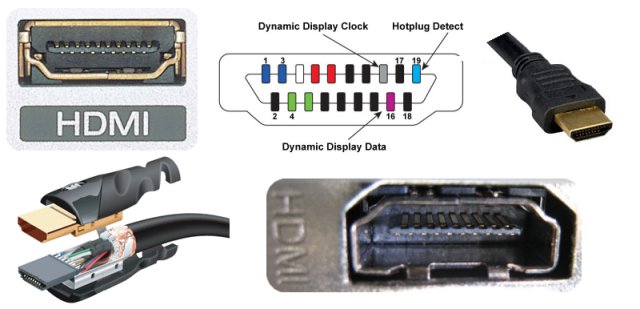High Definition Multimedia Interface (HDMI)
HDMI is a type of Standard Video Device Connector that carries the same video signal as DVI, but instead of using the remaining pins for an optional video signal, pins are used to carry seven digital audio channels. HDMI is a method for connecting a video and audio source device such as a set-top box or DVD player to a display device using a single cable. HDMI connectors are now appearing on some computers, typically on new video cards and video capture devices.
Unlike PC VGA, HDMI is all digital. HDMI has superior video quality when compared to Component Video, S-Video, and Composit. HDMI includes the audio as well as video, unlike the aforementioned video cable types.
HDMI handles both Video and Sound. With 19 wires wrapped in a single cable, HDMI is able to carry a bandwidth of 5 Gbps (gigabits per second). This is more than twice the bandwidth needed to transmit multi-channel audio and video.
Because all HDMI devices are HDCP compliant, the HDMI advantage is overshadowed by anti-copy technology that cripples video equipment with HDMI connectors. Consumers should understand the dirty tricks being imposed by Intel, the MPAA, and manufacturers pushing for HDMI dominance.
High-bandwidth Digital Content Protection (HDCP), as mentioned above, is a technology that prevents you, the consumer, from backing up or making copies of your video media that you own. All HDMI devices have built in HDCP anti copy technology.
Dish Network and DirecTV are now using HDMI connectors with HDCP copy protection. Many new video processors support DVI, but cannot display that content to the component video output due to the HDCP anti copy system.
The goal of HDMI is:
- One cable, one connector that does high quality video and sound.
- Prevent consumers from backing up or copying satellite TV programming and DVD, Bluray, and HD-DVD video and movies.
- Force the industry to adopt bastardized technology with built-in usage restrictions.
Pioneer Electronics is one of the culprits pushing HDMI technology, and their DV59-AVi was one of the first to market with HDMI jacks.
Wikipedia describes HDMI as "compact," however, with 19 wires wrapped in a single cord it is actually quite heavy and stiff, being somewhat difficult to work with in "in wall" applications, and limited in transmission range. The concept is primarily for simplicity so the consumer only has one cable to connect for all video color bands as well as high definition audio.
Critics point out that besides putting additional stress on the female socket of video equipment, connections from A/V equipment (like a Blu-Ray Player) to audio only equipment (stereo receiver separate from TV) is more complicated. Many experts believe that audio should not be carried by the same cable.
DVI is an alternative to HDMI, except there lacks a single DVI standard. DVI to HDMI converters are inexpensive, but some small degree of quality is lost in the conversion process. A newer technology called HDBaseT looks to possibly replace HDMI, which will be a welcome improvement.
